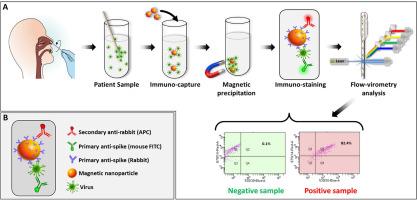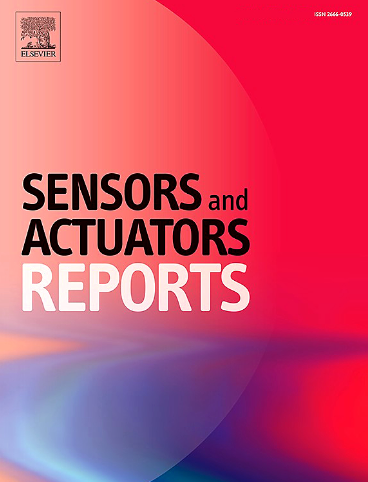MICaFVi 的实施和验证:基于纳米技术的冠状病毒高效检测方法
IF 6.5
Q1 BIOTECHNOLOGY & APPLIED MICROBIOLOGY
引用次数: 0
摘要
由于引起 COVID-19 的中东呼吸综合征冠状病毒(MERS-CoV)和严重急性呼吸系统综合征冠状病毒 2(SARS-CoV-2)的全球影响,冠状病毒已成为一个重大的公共卫生问题。开发灵敏准确的检测方法对于早期诊断、疾病管理和疫情控制至关重要。在之前的一项研究中,我们利用病毒模拟硅纳米粒子和 MERS-CoV/SARS-CoV-2 伪病毒粒子,开发并优化了一种名为 "流式病毒测定法磁性免疫捕获(MICaFVi)"的纳米检测方法。在本研究中,我们扩展了这一方法,以评估其检测人类和骆驼样本中野生型 MERS-CoV 和 SARS-CoV-2 的特异性和灵敏度。我们的结果表明,MICaFVi 成功地检测出了 MERS-CoV 和 SARS-CoV-2 病毒,灵敏度和特异性都很高,但与 qPCR 相比,它在 Ct 值为 30 或更低的样本中的表现有所下降。尽管 MICaFVi 在检测速度和灵敏度方面存在一些局限性,但通过将纳米技术与流式细胞术相结合,它代表了诊断方法的一大进步。此外,我们还对 MICaFVi 方法进行了改良,使其能在一次多重检测中同时检测 MERS-CoV 和 SARS-CoV-2 。这种先进检测方法的成功应用对改善当前和未来病毒或细菌流行病的早期检测、监测和控制具有重要意义。我们的研究结果强调了 MICaFVi 作为监测这些病毒传播的重要工具的潜力,并突出了它在推动诊断技术发展方面的作用。这是对我们早期工作的扩展,为纳米技术和流式细胞术在病毒检测中的应用提供了新的见解。本文章由计算机程序翻译,如有差异,请以英文原文为准。

Implementation and validation of MICaFVi: A highly efficient nanotechnology-based method for coronaviruses detection
Coronaviruses have emerged as a significant public health concern due to the global impact of Middle East respiratory syndrome coronavirus (MERS-CoV) and severe acute respiratory syndrome coronavirus 2 (SARS-CoV-2), which cause COVID-19. The development of sensitive and accurate detection methods is critical for early diagnosis, disease management, and outbreak control. In a previous study, we developed and optimized a nanobased detection methodology called Magnetic Immuno-Capture Followed by Flow Virometry (MICaFVi) using virus-mimicking silica nanoparticles and MERS-CoV/SARS-CoV-2 pseudoviral particles. In the present study, we have extended this methodology to evaluate its specificity and sensitivity for detecting wild-type MERS-CoV and SARS-CoV-2 in human and camel samples. Our results demonstrated that MICaFVi successfully detected MERS-CoV and SARS-CoV-2 viruses with high sensitivity and specificity, although it showed reduced performance for samples with Ct values of 30 or lower compared to qPCR. Despite some limitations in detection speed and sensitivity, MICaFVi represents a significant advancement in diagnostic methodologies by combining nanotechnology with flow cytometry. Additionally, we adapted the MICaFVi methodology to simultaneously detect MERS-CoV and SARS-CoV-2 in a single multiplex assay. The successful implementation of this advanced detection approach has important implications for improving early detection, surveillance, and control of both current and future viral or bacterial pandemics. Our results underscore the potential of MICaFVi as a valuable tool for monitoring the spread of these viruses and highlight its role in advancing diagnostic technologies. This extension of our earlier work offers new insights into the application of nanotechnology and flow cytometry for viral detection.
求助全文
通过发布文献求助,成功后即可免费获取论文全文。
去求助
来源期刊

Sensors and Actuators Reports
Multiple-
CiteScore
9.60
自引率
0.00%
发文量
60
审稿时长
49 days
期刊介绍:
Sensors and Actuators Reports is a peer-reviewed open access journal launched out from the Sensors and Actuators journal family. Sensors and Actuators Reports is dedicated to publishing new and original works in the field of all type of sensors and actuators, including bio-, chemical-, physical-, and nano- sensors and actuators, which demonstrates significant progress beyond the current state of the art. The journal regularly publishes original research papers, reviews, and short communications.
For research papers and short communications, the journal aims to publish the new and original work supported by experimental results and as such purely theoretical works are not accepted.
 求助内容:
求助内容: 应助结果提醒方式:
应助结果提醒方式:


